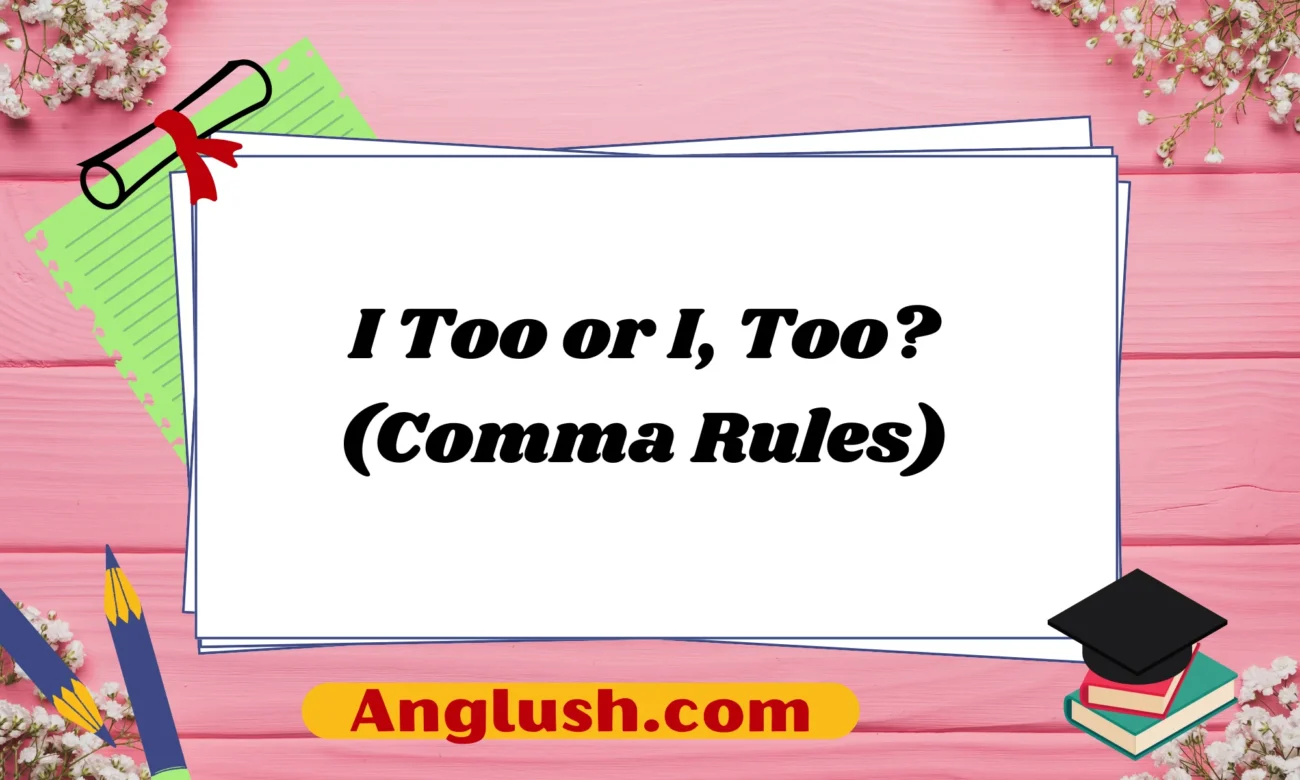Introduction
When it comes to English grammar, even small punctuation marks can significantly impact the meaning and clarity of a sentence. One common area of confusion is whether to use a comma in the phrase “I too” or “I, too”. This article will break down the rules for using commas in this phrase, provide alternative ways to express agreement or inclusion, and offer examples of how different contexts influence word choice.
By the end of this article, you’ll have a clear understanding of when to use a comma, how to maintain professionalism or casualness in conversations, and alternative expressions that suit different situations.
The Difference Between “I Too” and “I, Too”
The core issue in deciding between “I too” and “I, too” is punctuation—specifically, whether a comma is necessary.
1. When to Use “I, Too” (With a Comma)
A comma should be used when “too” is functioning as an interrupter. This means it is offering an additional thought within the sentence, much like the word “also” does. The comma helps clarify that “too” is an extra element.
✅ Correct Example:
- I, too, would like to attend the meeting.
- She, too, was surprised by the news.
In both cases, the commas provide clarity, ensuring the reader understands that “too” is not essential to the main sentence but adds emphasis.
2. When to Use “I Too” (Without a Comma)
When “too” is closely connected to the verb and does not interrupt the sentence, a comma is not necessary.
✅ Correct Example:
- I too want to help with the project.
- They too deserve recognition for their efforts.
Here, “too” is more naturally integrated into the sentence structure, making the comma unnecessary.
Key Takeaway:
Use “I, too,” when adding emphasis or making a clear interruption. Use “I too” when the phrase flows naturally without the need for a pause.
Alternatives to “I Too” and “I, Too”
While “I too” and “I, too” are grammatically correct, there are many alternative ways to express agreement or inclusion. These alternatives can vary in formality, making them useful for different contexts.
1. Formal Alternatives
These expressions are suitable for professional settings, business emails, and polite conversations.
- I also agree.
- I share the same opinion.
- I am of the same view.
- I feel the same way.
- I concur.
✅ Example:
- Manager: “We should implement this strategy.”
- Employee: “I concur.”
2. Polite & Neutral Alternatives
These expressions work well in casual workplaces, friendly discussions, and everyday interactions.
- Me as well.
- I feel the same.
- Same here.
- That’s how I see it too.
- I’m with you on this.
✅ Example:
- Friend: “I love this movie!”
- You: “Same here!”
3. Casual & Friendly Alternatives
These are best for texting, chatting with friends, and informal conversations.
- Me too!
- Yep, same!
- Ditto!
- You read my mind!
- Right there with you!
✅ Example:
- Friend: “I could go for some pizza right now.”
- You: “Ditto!”
Choosing the Right Expression Based on Context
Understanding tone and context is key to selecting the best alternative to “I too” or “I, too.” Here are some examples of how different expressions work in various situations:
1. Professional & Work-Related Situations
✅ Example:
- Colleague: “I believe we should prioritize this task.”
- You: “I also agree.” (Formal)
✅ Example:
- Boss: “This report needs adjustments.”
- You: “I share the same opinion.” (Polite)
2. Everyday Conversations
✅ Example:
- Friend: “This café has the best coffee.”
- You: “Me as well!” (Neutral)
✅ Example:
- Sibling: “I want to go to the beach this weekend.”
- You: “That’s how I see it too!” (Friendly)
3. Casual & Playful Interactions
✅ Example:
- Friend: “I need a nap!”
- You: “Same here!” (Casual)
✅ Example:
- Coworker: “Mondays are the worst.”
- You: “Right there with you!” (Playful)
11 User-Friendly Texting Examples
Here are some texting-friendly ways to express agreement, optimized for clarity and readability:
- “Me too!”
- “Same here!”
- “Yep, same!”
- “I feel the same way!”
- “Ditto!”
- “I agree 100%!”
- “Right there with you!”
- “You took the words right out of my mouth!”
- “Exactly what I was thinking!”
- “Couldn’t agree more!”
- “That’s my thought too!”
Each of these responses is concise, easy to understand, and ideal for text messages or social media comments.
Conclusion
Deciding between “I too” and “I, too” comes down to punctuation rules. If “too” is used as an interrupter, a comma is necessary (“I, too, would like to join”). If “too” is naturally part of the sentence without a pause, no comma is needed (“I too want to join”).
Beyond grammar, choosing the right alternative expression depends on the tone and context. Whether you’re in a professional setting, having a polite conversation, or chatting casually with friends, there are plenty of ways to express agreement naturally.

